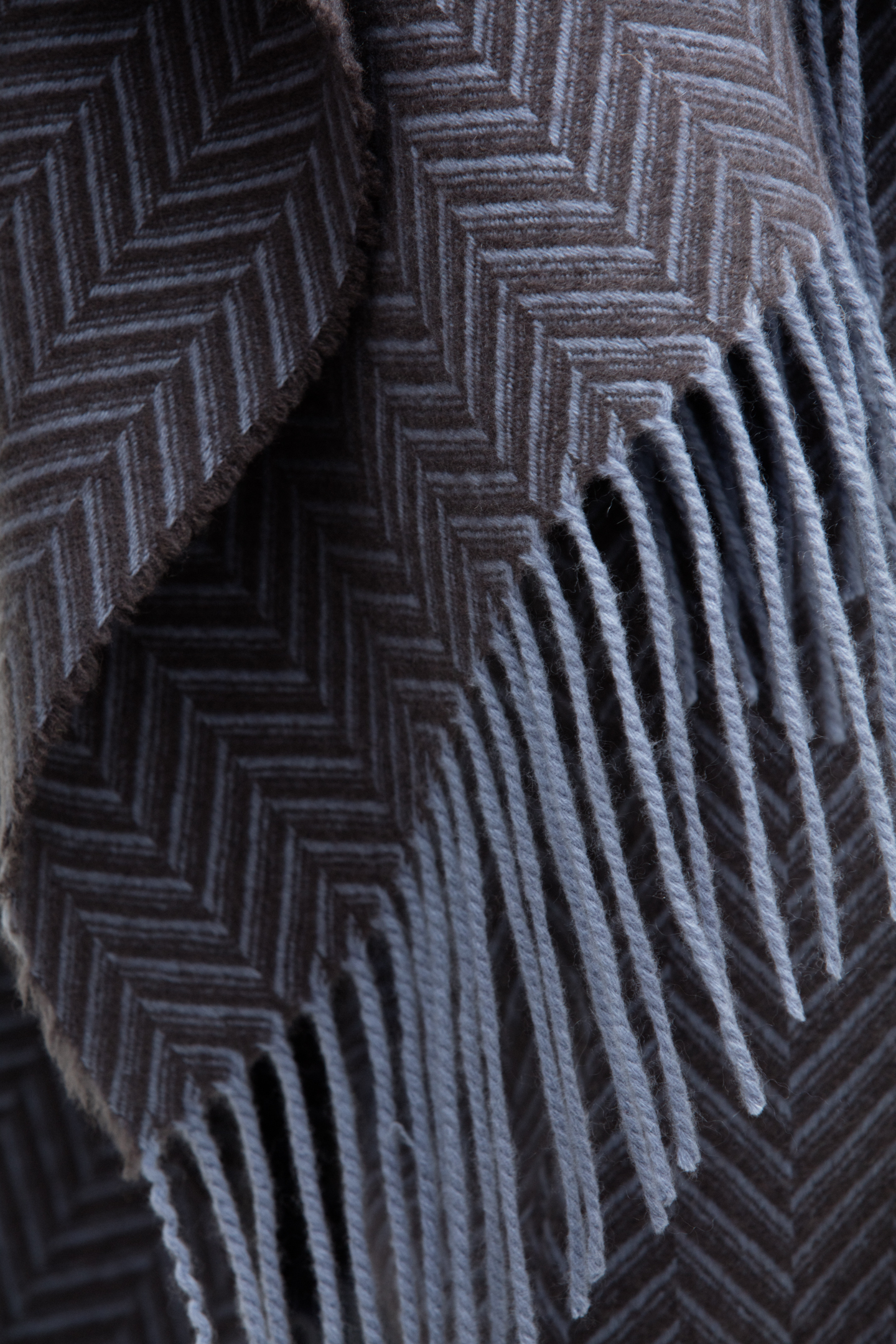Herringbone
Das Herringbone Muster (auf Englisch herringbone pattern) ist ein klassisches und zeitloses Textildesign, das seinen Namen von der Ähnlichkeit mit den Gräten eines Herings ableitet. Herringbone bedeutet in der Übersetzung auf Deutsch nichts anderes als „Fischgrätmuster“ oder „Fischgrätenmuster“, was das Zickzackmuster treffend beschreibt.
In der Mode hat sich das Herringbone zu einem festen Bestandteil etabliert und steht für Qualität, Handwerkskunst und Eleganz. Sein vielseitiges Design macht es zu einem beliebten Klassiker, der sich bei vielen traditionellen Kleidungsstücken wiederfindet und der ganz typisch für den britischen Kleidungsstil ist.

Was ist Herringbone?
Herringbone ist ein Textilmuster, das beim Weben entsteht. Es ist ein kompliziertes Gewebe, das bei jedem Richtungswechsel die Farbe wechselt. So wird durch die abwechselnde Ausrichtung der Kett- und Schussfäden das charakteristische Zickzack-Design erzeugt. Diese Technik wird als gebrochene Köperbindung bezeichnet. Die Anordnung der Fäden in diagonalen Linien verleiht dem Stoff seine unverwechselbare Struktur und Optik.
Das Fischgrät Muster gehört zu den ältesten und ursprünglichsten Gestaltungselementen in der Textilherstellung überhaupt. Schon in der Hallstattzeit (ca. 800 v.Chr.) und im frühen Mittelalter wurden Fischgratgewebe hergestellt, wie archäologische Funde gezeigt haben.
Im Laufe der Zeit hat sich Herringbone in der Mode- und Textilindustrie zu einem bekannten und etablierten Design entwickelt.
In der Modewelt erlebte Herringbone seinen Durchbruch im 19. Jahrhundert und wurde schnell zu einem Symbol für klassische Eleganz und hochwertige Handwerkskunst. Denn Herringbone Stoffe sind nicht nur ästhetisch besonders attraktiv, sondern durch ihre besondere Struktur auch besonders fest und robust. Aufgrund ihrer Haltbarkeit und Strapazierfähigkeit wurden Herringbone-Stoffe traditionell besonders gerne für klassische Outdoor Bekleidung wie z.B. Jagd-Jacken und -Westen genutzt.
Aus den gleichen Gründen wird Herringbone auch gerne bei der Inneneinrichtung und der Herstellung von Heimtextilien verwendet und kommt oftmals bei Polsterstoffen, Teppichen oder Vorhängen zum Einsatz.
weiter lesen
Herringbone in der Mode: Verwendung des Musters
In der Modewelt hat das Herringbone Muster einen besonderen Platz. Es wird vor allem bei der Herstellung von klassischen Anzügen, Blazern, Mänteln, Sakkos, Schals und Mützen verwendet. Das Herringbone verleiht den Kleidungsstücken Struktur und Tiefe, ohne dabei aufdringlich zu wirken. Besonders in der Herrenmode ist das Fischgrätmuster beliebt, da es gleichzeitig Seriosität und zurückhaltende Eleganz ausdrückt.
Doch auch in der Damenmode wird Herringbone Muster eingesetzt. Ob als Mantel, Blazer, Kostüm, Kleid, Plaid oder Hut – das Fischgrätmuster sorgt immer für einen klassischen stilvollen Auftritt.
Seine Vielseitigkeit zeigt sich in den zahlreichen Variationen und Materialien, die dieses Muster zulässt. Egal ob aus Wolle, Baumwolle oder Leinen – Herringbone Mode passt sich den Bedürfnissen der Träger an und bietet eine zeitlose, raffinierte Ästhetik.
Materialien
Das Fischgrätmuster wird häufig aus Wolle gewebt. Vor allem bei typisch britischen Tweed-Stoffen für Blazer, Kostüme, Sakkos und Wollmäntel kommt es häufig zum Einsatz.
Es ist jedoch auch in anderen Materialien wie Baumwolle, Leinen oder Mischgeweben erhältlich.
Dank seiner Struktur bietet es ein angenehmes Tragegefühl und zeichnet sich durch seine Langlebigkeit aus.
Das Herringbone Strickmuster (englisch: Herringbone Stitch) wird zudem bei Strickwaren eingesetzt und verleiht Knitwear eine elegante und zugleich pure Note.
Pflegehinweise von Herringbone-Stoffen
Die Pflege von Kleidungsstücken mit Fischgrätenmuster hängt stark vom verwendeten Material ab. Zunächst sollten deshalb immer als Erstes die Pflegehinweise auf dem Etikett beachtet werden, um die Langlebigkeit des Kleidungsstücks zu gewährleisten.
- Wolle und Tweed: Sie sollten generell eher mit Handwäsche oder im Wollwaschprogramm und einem milden Waschmittel gereinigt werden. Anschließend am besten flach trocknen, um die Form zu bewahren.
- Baumwolle und Leinen: Sie können in der Waschmaschine gewaschen werden. Dabei aber hohe Temperaturen vermeiden, damit die Textilien nicht einlaufen.
- Synthetische Fasern: Sie sind oft besonders pflegeleicht und können auf normalen Temperaturen gewaschen und getrocknet werden.
